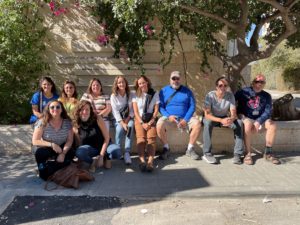Written by Seth Albin
Today, we started with another wonderful Israeli breakfast and had our PCR tests in anticipation of coming home.
After breakfast, we hopped on the bus and headed to the Max Rayne Hand in Hand School Jerusalem, which was opened in 1998. On the way to the school, we learned about the Israeli school system and the difficulties in designing a public school system that meets the diverse needs of the various groups, secular, National Zionist Orthodox, Ultra Orthodox, and Muslim.
The Hand in Hand program has seven different schools (K-12) throughout Israel. In each school, the children are taught in both Arabic and Hebrew. There are two teachers in each classroom, one Hebrew and one Arabic. By learning together the students learn about each other and accept their differences.
We met with Kutz, a 10th grader. She told us that she loves the school because it has helped her to have new perspectives and thoughts about Jews and Arabs and has allowed her to become a more open person. We also met with the elementary school principal and learned a little about the curriculum is designed.
After our visit to Hand in Hand, we went to the Jerusalem College of Technology, which has the goal of supplying manpower to build Israel’s high tech industry. We met with faculty and students in one particular program that specifically targets members of the Ultra-Orthodox community, many of whom do not have more than a rudimentary education. To participate in the program, students must first complete a year long course of study that provides them the basic education foundation that they are lacking.
After a quick lunch on our own, we headed to Mt. Herzel, which is the Israeli equivalent of Arlington National Cemetery. We took a tour of the grounds and saw headstones from different eras and the meaning behind them.
We walked from Mt. Herzl to Yad Vashem, which is considered the foremost memorial and historical museum for victims of the Shoah. We had a two-hour guided tour from a docent from the museum. We learned about the historical origins, life in the various ghettos and concentration camps, liberation, and post-war life for the victims. We also toured the children’s museum and learned about the work of the center to identify and record victims that survived and those who did not.
After Yad Vashem, we came back to the hotel to freshen up and had a wonderful meal together. After dinner, we shopped along Ben Yahuda Street and then finally passed out after a wonderfully exhausting day.






